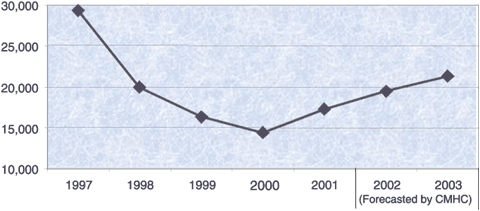Housing and Building — Continued
Goal: Housing needs and safe building standards are met
Planning Context
During the past two years, low interest rates and rising consumer
confidence have contributed to a robust housing market. The Canada
Mortgage and Housing Corporation (CMHC) expects this to continue.
In the resale housing market, there were only 54,179 Multiple
Listings Service (MLS) transactions in 2000. MLS transactions
rose to 69,430 in 2001, demonstrating the recovery in the market.
CMHC expects the number of MLS transactions to continue improving,
to a forecasted 73,000 residential sales in 2003.
Housing Starts in British Columbia 1997-2003

Buoyed by continued low interest rates and strong consumer confidence,
housing is expected to be one of the sectors leading the economic
recovery of British Columbia.
However, affordability continues to be an issue. In 2001, the
average price of a house on the resale market in British Columbia
was $222,822, by far the highest in the country. CMHC is forecasting
the average MLS price in British Columbia to be $238,300 by 2003,
$399,000 in Greater Vancouver.
In the rental housing market, supply has lagged far behind demand
in recent years. Only 20,000 market rental housing units were
built in British Columbia in the last decade. Throughout the 1990s,
market rental units accounted for only six per cent of all units
built despite the fact that renters make up 35 per cent of households
in the province. In 2001, the vacancy rate was one per cent in
Vancouver and 0.5 per cent in Victoria. A healthy vacancy rate
is considered to be three per cent. The lack of supply and rising
rental rates have led to an increasing need for housing options
for low-income households.
Consumer protection and pressure to increase assistance to owners
of leaky condominiums remain on-going issues for government. There
is also a risk that the vulnerable housing clients may be impacted
by changes in other ministries’ social support programs.
| Objectives |
Key Strategies |
| 1. The housing market thrives. |
• Develop housing industry stimulation options for
the implementation of the new provincial housing policy.
• Provide consultation and request for change in legislation
to amend the Homeowner Protection Act.
|
| 2. The most vulnerable British
Columbians are housed. |
• Develop options for the implementation of the new
provincial housing policy.
|
| 3. British Columbia has
a modern building regulatory system for safe, healthy and
accessible buildings. |
• Participate in development of new national objective-based
building and plumbing codes.
• Develop proposals for a modern, efficient building
regulatory system.
• Establish and implement a mechanism for code interpretation
services for all provincial users.
|
